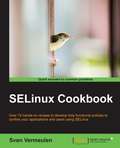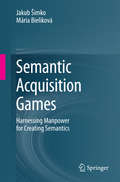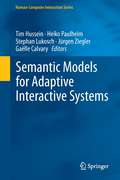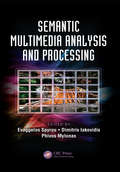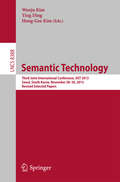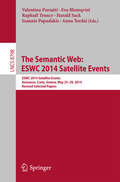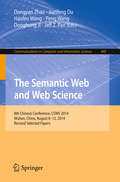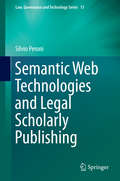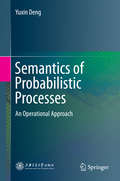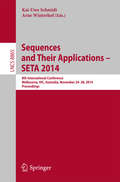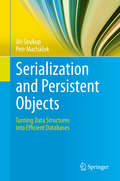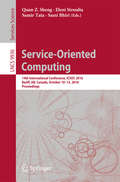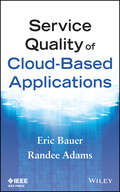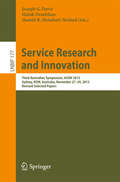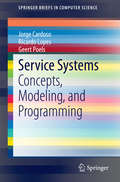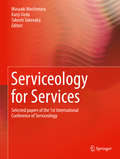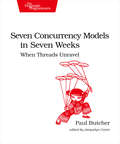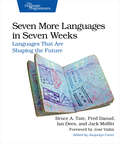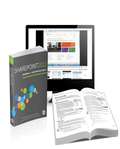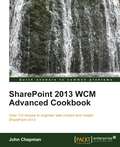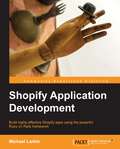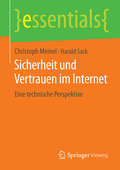- Table View
- List View
SELinux Cookbook
by Sven VermeulenIf you are a Linux system administrator or a Linux-based service administrator and want to fine-tune SELinux to implement a supported, mature, and proven access control system, then this book is for you. Basic experience with SELinux enabled distributions is expected.
Semantic Acquisition Games
by Jakub Šimko Mária BielikováMany applications depend on the effective acquisition of semantic metadata, and this state-of-the-art volume provides extensive coverage of the field of semantics acquisition games (SAGs). SAGs are a part of the crowdsourcing approach family and the authors analyze their role as tools for acquisition of resource metadata and domain models. Three case studies of SAG-based semantics acquisition methods are shown, along with other existing SAGs: 1. the Little Search Game - a search query formulation game using negative search, serving for acquisition of lightweight semantics. 2. the PexAce - a card game acquiring annotations to images. 3. the CityLights - a SAG used for validation of music metadata. The authors also look at the SAGs from their design perspectives covering SAG design issues and existing patterns, including several novel patterns. For solving cold start problems, a "helper artifact" scheme is presented, and for dealing with malicious player behavior, a posteriori cheating detection scheme is given. The book also presents methods for assessing information about player expertise, which can be used to make SAGs more effective in terms of useful output.
Semantic Models for Adaptive Interactive Systems
by Tim Hussein Jürgen Ziegler Heiko Paulheim Stephan Lukosch Gaëlle CalvaryProviding insights into methodologies for designing adaptive systems based on semantic data, and introducing semantic models that can be used for building interactive systems, this book showcases many of the applications made possible by the use of semantic models. Ontologies may enhance the functional coverage of an interactive system as well as its visualization and interaction capabilities in various ways. Semantic models can also contribute to bridging gaps; for example, between user models, context-aware interfaces, and model-driven UI generation. There is considerable potential for using semantic models as a basis for adaptive interactive systems. A variety of reasoning and machine learning techniques exist that can be employed to achieve adaptive system behavior. The advent and rapid growth of Linked Open Data as a large-scale collection of semantic data has also paved the way for a new breed of intelligent, knowledge-intensive applications. Semantic Models for Adaptive Interactive Systems includes ten complementary chapters written by experts from both industry and academia. Rounded off by a number of case studies in real world application domains, this book will serve as a valuable reference for researchers and practitioners exploring the use of semantic models within HCI.
Semantic Multimedia Analysis and Processing (Digital Imaging and Computer Vision #9)
by Evaggelos SpyrouBroad in scope, Semantic Multimedia Analysis and Processing provides a complete reference of techniques, algorithms, and solutions for the design and the implementation of contemporary multimedia systems. Offering a balanced, global look at the latest advances in semantic indexing, retrieval, analysis, and processing of multimedia, the book features the contributions of renowned researchers from around the world. Its contents are based on four fundamental thematic pillars: 1) information and content retrieval, 2) semantic knowledge exploitation paradigms, 3) multimedia personalization, and 4) human-computer affective multimedia interaction. Its 15 chapters cover key topics such as content creation, annotation and modeling for the semantic web, multimedia content understanding, and efficiency and scalability. Fostering a deeper understanding of a popular area of research, the text: Describes state-of-the-art schemes and applications Supplies authoritative guidance on research and deployment issues Presents novel methods and applications in an informative and reproducible way Contains numerous examples, illustrations, and tables summarizing results from quantitative studies Considers ongoing trends and designates future challenges and research perspectives Includes bibliographic links for further exploration Uses both SI and US units Ideal for engineers and scientists specializing in the design of multimedia systems, software applications, and image/video analysis and processing technologies, Semantic Multimedia Analysis and Processing aids researchers, practitioners, and developers in finding innovative solutions to existing problems, opening up new avenues of research in uncharted waters.
Semantic Technology
by Wooju Kim Ying Ding Hong-Gee KimThis book constitutes the proceedings of the Third Joint International Semantic Technology Conference, JIST 2013, held in Seoul, South Korea, in November 2013. The 32 papers, included four tutorials and 5 workshop papers, in this volume were carefully reviewed and selected from numerous submissions. The contributions are organized in topical sections on semantic Web services, multilingual issues, biomedical applications, ontology construction, semantic reasoning, semantic search and query, ontology mapping, and learning and discovery.
Semantic Technology: Third Joint International Conference, JIST 2013, Seoul, South Korea, November 28--30, 2013, Revised Selected Papers (Lecture Notes in Computer Science #8388)
by Wooju Kim, Ying Ding and Hong-Gee KimThis book constitutes the proceedings of the Third Joint International Semantic Technology Conference, JIST 2013, held in Seoul, South Korea, in November 2013.The 32 papers, included four tutorials and 5 workshop papers, in this volume were carefully reviewed and selected from numerous submissions. The contributions are organized in topical sections on semantic Web services, multilingual issues, biomedical applications, ontology construction, semantic reasoning, semantic search and query, ontology mapping, and learning and discovery.
The Semantic Web: ESWC 2014 Satellite Events
by Valentina Presutti Eva Blomqvist Raphael Troncy Harald Sack Ioannis Papadakis Anna TordaiThis book constitutes the thoroughly refereed post-conference proceedings of the Satellite Events of the 11th International Conference on the Semantic Web, ESWC 2014, held in Anissaras, Crete, Greece, in May 2014. The volume contains 20 poster and 43 demonstration papers, selected from 113 submissions, as well as 12 best workshop papers selected from 60 papers presented at the workshop at ESWC 2014. Best two papers from AI Mashup Challenge are also included. The papers cover various aspects of the Semantic Web.
The Semantic Web and Web Science
by Dongyan Zhao Jianfeng Du Haofen Wang Peng Wang Donghong Ji Jeff Z. PanThis book constitutes the thoroughly refereed papers of the 8th Chinese Conference on The Semantic Web and Web Science, CSWS 2014, held in Wuhan, China, in August 2014. The 22 research papers presented were carefully reviewed and selected from 61 submissions. The papers are organized in topical sections such as ontology reasoning and learning; semantic data generation and management; and semantic technology and applications.
The Semantic Web Explained
by Peter Szeredi Gergely Lukacsy Tamas BenkoThe Semantic Web is a new area of research and development in the field of computer science that aims to make it easier for computers to process the huge amount of information on the web, and indeed other large databases, by enabling them not only to read, but also to understand the information. Based on successful courses taught by the authors, and liberally sprinkled with examples and exercises, this comprehensive textbook describes not only the theoretical issues underlying the Semantic Web, but also algorithms, optimisation ideas and implementation details. The book will therefore be valuable to practitioners as well as students, indeed to anyone who is interested in Internet technology, knowledge engineering or description logics. Supplementary materials available online include the source code of program examples and solutions to selected exercises.
Semantic Web Technologies and Legal Scholarly Publishing
by Silvio PeroniThis work deals with the applications of Semantic Publishing technologies in the legal domain, i. e. , the use of Semantic Web technologies to address issues related to the Legal Scholarly Publishing. Research in the field of Law has a long tradition in the application of semantic technologies, such as Semantic Web and Linked Data, to real-world scenarios. This book investigates and proposes solutions for three main issues that Semantic Publishing needs to address within the context of the Legal Scholarly Publishing: the need of tools for linking document text to a formal representation of its meaning; the lack of complete metadata schemas for describing documents according to the publishing vocabulary and the absence of effective tools and user interfaces for easily acting on semantic publishing models and theories. In particular, this work introduces EARMARK, a markup meta language that allows one to create markup documents without the structural and semantic limits imposed by markup languages such as XML. EARMARK is a platform to link the content layer of a document with its intended formal semantics and it can be used with the Semantic Publishing and Referencing (SPAR) Ontologies, another topic in this book. SPAR Ontologies are a collection of formal models providing an upper semantic layer for describing the publishing domain. Using EARMARK as a foundation for SPAR descriptions opens up to a semantic characterisation of all the aspects of a document and of its parts. Finally, four user-friendly tools are introduced: LODE, KC-Viz, Graffoo and Gaffe. They were expressly developed to facilitate the interaction of publishers and domain experts with Semantic Publishing technologies by shielding such users from the underlying formalisms and semantic models of such technologies.
Semantics of Probabilistic Processes
by Yuxin DengThis book discusses the semantic foundations of concurrent systems with nondeterministic and probabilistic behaviour. Particular attention is given to clarifying the relationship between testing and simulation semantics and characterising bisimulations from metric, logical, and algorithmic perspectives. Besides presenting recent research outcomes in probabilistic concurrency theory, the book exemplifies the use of many mathematical techniques to solve problems in computer science, which is intended to be accessible to postgraduate students in Computer Science and Mathematics. It can also be used by researchers and practitioners either for advanced study or for technical reference.
Sequences and Their Applications - SETA 2014
by Kai-Uwe Schmidt Arne WinterhofThis book constitutes the refereed proceedings of the 8th International Conference on Sequences and Their Applications, SETA 2014, held in Melbourne, VIC, Australia, in November 2014. The 24 full papers presented together with 2 invited papers were carefully reviewed and selected from 36 submissions. The papers have been organized in topical sections on Boolean functions, perfect sequences, correlation of arrays, relative difference sets, aperiodic correlation, pseudorandom sequences and stream ciphers, crosscorrelation of sequences, prime numbers in sequences, OFDM and CDMA, and frequency-hopping sequences.
Serialization and Persistent Objects
by Jiri Soukup Petr MacháčekRecently, the pressure for fast processing and efficient storage of large data with complex relations increased beyond the capability of traditional databases. Typical examples include iPhone applications, computer aided design - both electrical and mechanical, biochemistry applications, and incremental compilers. Serialization, which is sometimes used in such situations is notoriously tedious and error prone. In this book, Jiri Soukup and Petr MacháÄ ek show in detail how to write programs which store their internal data automatically and transparently to disk. Together with special data structure libraries which treat relations among objects as first-class entities, and with a UML class-diagram generator, the core application code is much simplified. The benchmark chapter shows a typical example where persistent data is faster by the order of magnitude than with a traditional database, in both traversing and accessing the data. The authors explore and exploit advanced features of object-oriented languages in a depth hardly seen in print before. Yet, you as a reader need only a basic knowledge of C++, Java, C#, or Objective C. These languages are quite similar with respect to persistency, and the authors explain their differences where necessary. The book targets professional programmers working on any industry applications, it teaches you how to design your own persistent data or how to use the existing packages efficiently. Researchers in areas like language design, compiler construction, performance evaluation, and no-SQL applications will find a wealth of novel ideas and valuable implementation tips. Under http://www. codefarms. com/book, you will find a blog and other information, including a downloadable zip file with the sources of all the listings that are longer than just a few lines - ready to compile and run.
Service-Oriented Computing
by Quan Z. Sheng Eleni Stroulia Samir Tata Sami BhiriThis book constitutes the refereed conference proceedings of the 12th International Conference on Service-Oriented Computing, ICSOC 2014, held in Paris, France, in November 2014. The 25 full and 26 short papers presented were carefully reviewed and selected from 180 submissions. The papers are organized in topical sections on business process management; service composition and discovery; service design, description and evolution; cloud and business service management; ensuring composition properties; quality of service; semantic web services; service management; cloud service management; business service management; trust; service design and description.
Service Quality of Cloud-Based Applications
by Eric Bauer Randee AdamsThis book explains why applications running on cloud might not deliver the same service reliability, availability, latency and overall quality to end users as they do when the applications are running on traditional (non-virtualized, non-cloud) configurations, and explains what can be done to mitigate that risk.
Service Research and Innovation
by Joseph G. Davis Haluk Demirkan Hamid R. Motahari-NezhadThis book constitutes the thoroughly refereed proceedings of the Third Australian Symposium on Service Research and Innovation, ASSRI 2013, held in Sydney, NSW, Australia, in November 2013. Overall, eight research papers were carefully reviewed and selected from 18 submissions. They are multidisciplinary in scope and cover strategic, organizational, and technological dimensions, ranging from purely conceptual to concrete implementations and testing of service-related technological platforms. Taken together, these papers provide a snapshot of the critical concerns and developments in service-related research and cover some of the key areas of research focus.
Service Systems
by Jorge Cardoso Ricardo Lopes Geert PoelsThis SpringerBrief explores the internal workings of service systems. The authors propose a lightweight semantic model for an effective representation to capture the essence of service systems. Key topics include modeling frameworks, service descriptions and linked data, creating service instances, tool support, and applications in enterprises. Previous books on service system modeling and various streams of scientific developments used an external perspective to describe how systems can be integrated. This brief introduces the concept of white-box service system modeling as an approach to model the internal aspects and elements of service systems. This approach provides descriptions that can be used for service management, optimization, and analytics. Service Systems: Concepts, Modeling, and Programming is designed for researchers, teachers, and advanced-level students who want to learn about the new emerging field of service science and IS/IT practitioners who are looking for better ways to describe, model, and communicate services.
Serviceology for Services: Selected papers of the 1st International Conference of Serviceology (Communications In Computer And Information Science Ser. #1189)
by Masaaki Mochimaru Kanji Ueda Takeshi TakenakaServices are key activities in the globalization of the economy and also underlie the quality of life of local residents. The advanced work presented in this book was selected from the proceedings of the First International Conference on Serviceology (ICServ2013), held October 16–18, 2013 in Tokyo. This book provides a useful overall guide to the state of the art in theory and practice of services for researchers in various fields, including engineering, marketing, economics, and others. This work also facilitates the scientific systematization of services and promotes technological developments for solutions of industrial issues.
Seven Concurrency Models in Seven Weeks: When Threads Unravel
by Paul ButcherYour software needs to leverage multiple cores, handle thousands of users and terabytes of data, and continue working in the face of both hardware and software failure. Concurrency and parallelism are the keys, and Seven Concurrency Models in Seven Weeks equips you for this new world. See how emerging technologies such as actors and functional programming address issues with traditional threads and locks development. Learn how to exploit the parallelism in your computer's GPU and leverage clusters of machines with MapReduce and Stream Processing. And do it all with the confidence that comes from using tools that help you write crystal clear, high-quality code.This book will show you how to exploit different parallel architectures to improve your code's performance, scalability, and resilience. You'll learn about seven concurrency models: threads and locks, functional programming, separating identity and state, actors, sequential processes, data parallelism, and the lambda architecture.Learn about the perils of traditional threads and locks programming and how to overcome them through careful design and by working with the standard library. See how actors enable software running on geographically distributed computers to collaborate, handle failure, and create systems that stay up 24/7/365. Understand why shared mutable state is the enemy of robust concurrent code, and see how functional programming together with technologies such as Software Transactional Memory (STM) and automatic parallelism help you tame it.You'll learn about the untapped potential within every GPU and how GPGPU software can unleash it. You'll see how to use MapReduce to harness massive clusters to solve previously intractable problems, and how, in concert with Stream Processing, big data can be tamed. With an understanding of the strengths and weaknesses of each of the different models and hardware architectures, you'll be empowered to tackle any problem with confidence.What You Need:The example code can be compiled and executed on *nix, OS X, or Windows. Instructions on how to download the supporting build systems are given in each chapter.
Seven More Languages in Seven Weeks: Languages That Are Shaping the Future
by Bruce Tate Ian Dees Frederic Daoud Jack MoffittGreat programmers aren't born--they're made. The industry is moving from object-oriented languages to functional languages, and you need to commit to radical improvement. New programming languages arm you with the tools and idioms you need to refine your craft. While other language primers take you through basic installation and "Hello, World," we aim higher. Each language in Seven More Languages in Seven Weeks will take you on a step-by-step journey through the most important paradigms of our time. You'll learn seven exciting languages: Lua, Factor, Elixir, Elm, Julia, MiniKanren, and Idris.Learn from the award-winning programming series that inspired the Elixir language. Hear how other programmers across broadly different communities solve problems important enough to compel language development. Expand your perspective, and learn to solve multicore and distribution problems.In each language, you'll solve a non-trivial problem, using the techniques that make that language special. Write a fully functional game in Elm, without a single callback, that compiles to JavaScript so you can deploy it in any browser. Write a logic program in Clojure using a programming model, MiniKanren, that is as powerful as Prolog but much better at interacting with the outside world. Build a distributed program in Elixir with Lisp-style macros, rich Ruby-like syntax, and the richness of the Erlang virtual machine. Build your own object layer in Lua, a statistical program in Julia, a proof in code with Idris, and a quiz game in Factor.When you're done, you'll have written programs in five different programming paradigms that were written on three different continents. You'll have explored four languages on the leading edge, invented in the past five years, and three more radically different languages, each with something significant to teach you.
Sewing to Sell: How To Sell Locally & Online; The Beginner's Guide to Starting a Craft Business
by Virginia LindsayThe creator of Gingercake Patterns shows you how to share your passion for sewing with the world by starting a successful home business. Maybe you started sewing just for fun. But now you&’ve developed the skills and vision to turn your creative outlet into something more. Making the leap from hobbyist to professional can be intimidating—but Virginia Lindsay is here to help you get off the sidelines and sew your way to a job you truly enjoy. Drawing on her own experience, Lindsay guides you through every aspect of starting your own craft business, from finding your personal sewing style to creating a product line, identifying customers, equipping your studio, pricing and selling your work, marketing yourself, designing your own patterns, and handling the business and legal side of sewing. And that's not all! Virginia also shares 16 projects (all customer-tested) that you can personalize to start sewing and selling right now.
SharePoint 2013 Branding and UI Design eBook and SharePoint-videos.com Bundle
by Asif Rehmani John Ross Paul Stubbs Randy DrisgillPlan, design, and launch a brand in SharePoint If you are planning, designing, and launching your brand using SharePoint, this book and author trio will walk you through everything you need to know in an understandable and approachable way. From specific technologies such as master pages, page layouts, and CSS to offering best-practices and real-world experience for creating successful branding projects through SharePoint 2013, you will learn how to approach your branding project in effective new ways. This visual book provides step-by-step instructions in a simple and striking format that focuses on each of the tasks you will face in your own branding project. Explains the various approaches to SharePoint branding and methodologies for creating an engaging UI. Guides you through planning for branding and using the Design Manager to start a design. Addresses implementing modern web techniques such as HT ML5, jQuery, and mobile responsive design into SharePoint. Explores creating SharePoint branding for public facing websites as well as internal intranets, including a deep dive into how custom SharePoint branding is created from scratch. Provides coverage on designing apps for SharePoint.
SharePoint 2013 WCM Advanced Cookbook
by John ChapmanYou will be led carefully step-by-step through a detailed set of recipes. This book focuses on web content management using Microsoft SharePoint 2013 server. The practical examples are built logically throughout the chapters to create a common theme. This book is ideal for developers who want to broaden their understanding of the web content management features available with SharePoint 2013. It is assumed that you already have some experience using SharePoint and developing web content. Experience with Microsoft PowerShell and coding C# with Visual Studio will also be helpful, but is not essential.
Shopify Application Development
by Michael LarkinThis is an easy-to follow manual that will guide you through the entire process of application development with Shopify, beginning with the installation and configuration of your local development environment for your app to the deployment of the app to Heroku. If you are a web developer or a designer who wants to extend Shopify stores by building apps, then this book is for you. A basic understanding of programming concepts and some familiarity with Shopify is all that is required to get started with Shopify app development.
Sicherheit und Vertrauen im Internet: Eine technische Perspektive (essentials)
by Christoph Meinel Harald SackDas globale Internet ist ein offenes Netz, das heißt nicht begrenzt und für jedermann zugänglich. Allerdings hat diese Offenheit ihren Preis: Es gibt keine zentrale Kontrolle, die z. B. Unbefugten Einblick in die Kommunikation und damit in die Privatsphäre anderer Internetnutzer verwehren würde. Um dennoch einen ausreichenden Schutz der Vertraulichkeit und Privatsphäre zu gewährleisten, müssen in eigener Verantwortung Techniken und Tools aus der Kryptografie eingesetzt werden, die Nachrichten verschlüsseln oder deren Unversehrtheit sicherstellen helfen. Die Autoren zeigen unterschiedliche Wege auf, wie der Schutz der Privatsphäre im Internet wiederhergestellt werden kann.
